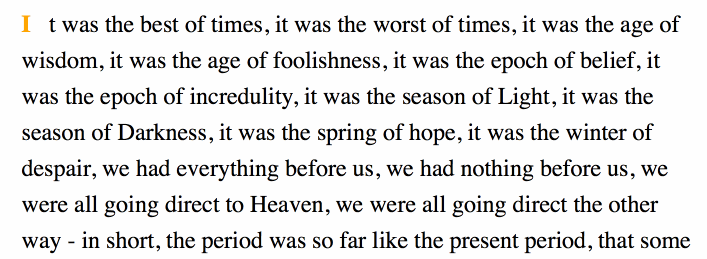| title | date |
|---|---|
Study Notes: Reading CSS Pseudo-Elements Module Level 4 |
2019-03-06 |
Original post by tae: Reading CSS Pseudo-Elements Module Level 4
that's little bit long spec.......... but finally I've done reading this!!
::first-linepseudo-element can only have an effect when attached to a block container. (that's not out-of flow due to floating or positioning)- fictional tag sequence helps to show how properties are inherited.
-
::first-letterpseudo-element can be used to create 'initial caps' and drop caps'- *dropcap : the first character of the first paragraph is made larger, taking up several lines of text or the first few sentences in typographic effects.
-
basically, UA may calculate how many columns ::first-letter for dropcap expand. with
initial-letterproperty, author can choose size of columns.(Changing the property to occupy 1, 2 and 4 lines) ** In pervious levels of CSS, User Agents were allowed to choose a line height, width and height based on the shape of the letter. This possibility has been intentionally removed, as it proved to be a poor solution for the intended use case (Drop caps). **
-
Following additional rules of each languages,
::first-letterdoesn't mean that 'ONE' character. In Dutch, the letter combination IJ appears at the beginning of an element. -
inherit from
::first-line -
For now,
::first-letteronly applies block container desendant -
p:before { content : 'Note'; }If:beforeelement exists, ::first-letter would be 'N' of note
- The UA should use the OS-default highlight colors for
::selctionwhen neighercolornorbackground-colorhas been specified by the author - Due to security problem, UA that implement ::spelling-error and ::grammer-error must prevent pages from being able to read the styling of such highlighted segments.
- Priority to paint the highlight : ::grammer-error > ::spelling-error > ::selection
- pseudo-elements represent the portion of a doucment that has been selected as the target or object of some possible future user-agent operations.
- Authors wanting multiple selections styles should use
root::selectionfor their document-wide selection style. because::selectionalone applies to every element in the tree ('*' is implied when a tag selector is missing)
- pseudo-element represents a portion of text that has been flagged by the user agent as misspelled.
- pseudo-element represnets a portion of text that has been flagged by the user agent as grammatically incorrect.
Tree-abiding pseudo-elements always fit within the box tree. They inherit any inheritable properties form their originating element
- As with the content of regular elements, the generated content of
::beforeand::afterpseudo-elements may be included in any::first-lineand::first-letterpseudo-elements applied to its originating element
- The
::markerpseudo-element represents the automatically generated marker box of a list item. In further CSS, list-item property will be deprecated. only::markerproperties are allowed.
The CSSPseudoElement interface allows pseudo-elements to be event targets.
[Exposed=Window]
interface CSSPseudoElement : EventTarget {
readonly attribute CSSOMString type;
readonly attribute Element element;
}
partial interface Element {
CSSPseudoElement? pseudo(CSSOMString type)
};
opposite side
For compatibility with existing style sheets written agianst CSS Level 2, UA must also accept the previous one-colon notation. (:before, :after, :first-letter, first-line) for the ::before, ::after, ::first-letter, and ::first-line pseudo-elements
- Originating Element of Tree-Abiding pseudo-elements
- Fictional tag sequence that causes Overlapping Pseudo-element Interactions
- Compatibility

